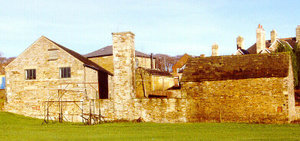
Millhouses
Encyclopedia

Sheffield
Sheffield is a city and metropolitan borough of South Yorkshire, England. Its name derives from the River Sheaf, which runs through the city. Historically a part of the West Riding of Yorkshire, and with some of its southern suburbs annexed from Derbyshire, the city has grown from its largely...
, England
England
England is a country that is part of the United Kingdom. It shares land borders with Scotland to the north and Wales to the west; the Irish Sea is to the north west, the Celtic Sea to the south west, with the North Sea to the east and the English Channel to the south separating it from continental...
. It is located in Ecclesall
Ecclesall
Ecclesall Ward—which includes the neighbourhoods of Bents Green, Ecclesall, Greystones, Millhouses, and Ringinglow—is one of the 28 electoral wards in City of Sheffield, England. It is located in the southwestern part of the city and covers an area of 9.4 km2. The population of...
ward; in the south-western portion of the city on the northwest bank of the River Sheaf
River Sheaf
The River Sheaf is a river in Sheffield, South Yorkshire, England. Its source is the union of the Totley Brook and the Old Hay Brook in Totley, now a suburb of Sheffield. It flows northwards, past Dore, through the valley called Abbeydale and north of Heeley...
. Its origins lie in a small hamlet
Hamlet (place)
A hamlet is usually a rural settlement which is too small to be considered a village, though sometimes the word is used for a different sort of community. Historically, when a hamlet became large enough to justify building a church, it was then classified as a village...
that grew around the Ecclesall Corn Mill. It has a population (2006 estimate) of 4424.
The agriculture and industries of this area are now largely gone, leaving Millhouses as a mostly residential area. Local amenities include three schools, a park, three pubs, three supermarkets, three churches and numerous small shops.
Geography
Millhouses is set in 1.55 km² (383 acre) of the part of the Sheaf valley known as Abbeydale. It is bordered to the southeast by the River SheafRiver Sheaf
The River Sheaf is a river in Sheffield, South Yorkshire, England. Its source is the union of the Totley Brook and the Old Hay Brook in Totley, now a suburb of Sheffield. It flows northwards, past Dore, through the valley called Abbeydale and north of Heeley...
and Hutcliff Wood
Hutcliff Wood
Hutcliff Wood and Marriott Wood are two areas of ancient woodland in Sheffield, South Yorkshire, England. They occupy the steep southeastern side of the Abbeydale valley between Archer Road and Abbey Lane, separated by the River Sheaf and the railway line from Millhouses Park...
, to the west by Ecclesall Woods
Ecclesall Woods
Ecclesall Woods is an area of woodland in south-west Sheffield, South Yorkshire, England, between Abbeydale Road South and Ecclesall. It covers approximately of mature semi-natural deciduous woodland which was previously used for timber and charcoal, and is currently managed by the city council...
, Millhouses Lane and Button Hill, and to the north by Carter Knowle Road and Bannerdale Road. Running directly alongside the River Sheaf is the long and thin Millhouses Park. The main road through the area is the A621 Abbeydale Road/Abbeydale Road South. The Midland Main Line
Midland Main Line
The Midland Main Line is a major railway route in the United Kingdom, part of the British railway system.The present-day line links London St...
also runs through Millhouses. Residential development was in a fan-shape focussed on the junction of Abbeydale Road and Millhouses Lane. Most houses in the area were built in the 1920s although there are some that date from the late 19th century.
History
In ancient times this area was part of the Barnsdale ForestBarnsdale
Barnsdale, or Barnsdale Forest, is a relatively small area of South Yorkshire, England which has a rich history and the region is steeped in folklore. Historically part of the West Riding of Yorkshire...
that, together with Sherwood Forest
Sherwood Forest
Sherwood Forest is a Royal Forest in Nottinghamshire, England, that is famous through its historical association with the legend of Robin Hood. Continuously forested since the end of the Ice Age, Sherwood Forest National Nature Reserve today encompasses 423 hectares surrounding the village of...
, made up the forest of the Robin Hood
Robin Hood
Robin Hood was a heroic outlaw in English folklore. A highly skilled archer and swordsman, he is known for "robbing from the rich and giving to the poor", assisted by a group of fellow outlaws known as his "Merry Men". Traditionally, Robin Hood and his men are depicted wearing Lincoln green clothes....
legends. The River Sheaf
River Sheaf
The River Sheaf is a river in Sheffield, South Yorkshire, England. Its source is the union of the Totley Brook and the Old Hay Brook in Totley, now a suburb of Sheffield. It flows northwards, past Dore, through the valley called Abbeydale and north of Heeley...
marked the boundary between the Anglo-Saxon kingdoms of Mercia
Mercia
Mercia was one of the kingdoms of the Anglo-Saxon Heptarchy. It was centred on the valley of the River Trent and its tributaries in the region now known as the English Midlands...
and Northumbria
Northumbria
Northumbria was a medieval kingdom of the Angles, in what is now Northern England and South-East Scotland, becoming subsequently an earldom in a united Anglo-Saxon kingdom of England. The name reflects the approximate southern limit to the kingdom's territory, the Humber Estuary.Northumbria was...
. In fact the earliest historical record of this area refers to the submission of the Northumbrian army to Egbert of Wessex
Egbert of Wessex
Egbert was King of Wessex from 802 until his death in 839. His father was Ealhmund of Kent...
at nearby Dore
Dore
Dore is a village in South Yorkshire, England. The village lies on a hill above the River Sheaf, and until 1934 was part of Derbyshire, but it is now a suburb of Sheffield. It is served by Dore and Totley railway station on the Hope Valley Line...
in 829.
In the late 12th century Robert Fitz Ranulf gave land for the establishment an abbey, just south of Millhouses at Beauchief
Beauchief Abbey
Beauchief Abbey is a former abbey in Sheffield, England. Beauchief is prounounced bee-chiff.-History:The abbey was founded by Robert FitzRanulf de Alfreton. Thomas Tanner, writing in 1695, stated that it was founded in 1183...
. Over time most the area now covered by Millhouses had been given to the abbey by the De Ecclesall family. One of the gifts to the monks was the Ecclesall Corn Mill. This mill existed at least as early as 1280 and considerable remnants of it can still be seen at the north end of Millhouses Park.
Millhouses remained mostly agricultural until the 19th century, although two cutlery
Cutlery
Cutlery refers to any hand implement used in preparing, serving, and especially eating food in the Western world. It is more usually known as silverware or flatware in the United States, where cutlery can have the more specific meaning of knives and other cutting instruments. This is probably the...
works had been established in the area: Moscar Wheel, which may originally have been a corn mill, was making cutlery by 1496, and Bartin Wheel was built as a cutler's wheel in 1631. In 1805 a turnpike road
Turnpike trust
Turnpike trusts in the United Kingdom were bodies set up by individual Acts of Parliament, with powers to collect road tolls for maintaining the principal highways in Britain from the 17th but especially during the 18th and 19th centuries...
was built from Sheffield to Bakewell
Bakewell
Bakewell is a small market town in the Derbyshire Dales district of Derbyshire, England, deriving its name from 'Beadeca's Well'. It is the only town included in the Peak District National Park, and is well known for the local confection Bakewell Pudding...
(now Abbeydale Road), this passed through the area and led to some growth, but it was only with the extension of the Midland Main Line
Midland Main Line
The Midland Main Line is a major railway route in the United Kingdom, part of the British railway system.The present-day line links London St...
through the valley in 1870 (with a railway station at Millhouses) and the subsequent arrival of tram
Tram
A tram is a passenger rail vehicle which runs on tracks along public urban streets and also sometimes on separate rights of way. It may also run between cities and/or towns , and/or partially grade separated even in the cities...
s in 1902 that Millhouses began to develop as an affluent residential suburb. As well as a railway station, an engine shed
Motive power depot
Motive power depot, usually abbreviated to MPD, is a name given to places where locomotives are stored when not being used, and also repaired and maintained. They were originally known as "running sheds", "engine sheds", or, for short, just sheds. Facilities are provided for refuelling and...
was built in 1901. This closed in the 1962, but the shed building is still in use as an industrial site and the shed's sidings
Rail siding
A siding, in rail terminology, is a low-speed track section distinct from a running line or through route such as a main line or branch line or spur. It may connect to through track or to other sidings at either end...
are now Tesco
Tesco
Tesco plc is a global grocery and general merchandise retailer headquartered in Cheshunt, United Kingdom. It is the third-largest retailer in the world measured by revenues and the second-largest measured by profits...
supermarket's Park and Ride
Park and ride
Park and ride facilities are car parks with connections to public transport that allow commuters and other people wishing to travel into city centres to leave their vehicles and transfer to a bus, rail system , or carpool for the rest of their trip...
.
Noteworthy buildings in Millhouses include the Grade II listed parish church, Holy Trinity, which was constructed in 1937, and the former Millhouses police station building that dates from 1893. The Robin Hood and Wagon and Horses public houses are amongst the neighbourhood's older surviving buildings, both dating from earlier than 1822.
Millhouses Park

Between Abbeydale Road South and the River Sheaf
River Sheaf
The River Sheaf is a river in Sheffield, South Yorkshire, England. Its source is the union of the Totley Brook and the Old Hay Brook in Totley, now a suburb of Sheffield. It flows northwards, past Dore, through the valley called Abbeydale and north of Heeley...
lies a mile-long public park, with a mixture of green spaces, planted areas and leisure facilities. These include tennis courts, a boating lake and a cafe serving gourmet food.
See also
- Districts of SheffieldDistricts of SheffieldSheffield is a city and metropolitan borough in the north of England. The neighbourhoods of Sheffield vary widely in size and history. Many of the neighbourhoods developed from villages or hamlets that have become absorbed into Sheffield as the city has grown...
- Millhouses engine shedMillhouses engine shedMillhouses engine shed was an engine shed in Millhouses, Sheffield. It was built by the Midland Railway in 1901 as Ecclesall engine shed, to serve the Midland Main Line. It was used mainly to stable passenger and mixed-traffic locomotives for use on trains from the nearby Sheffield Midland station...
- Millhouses railway station

